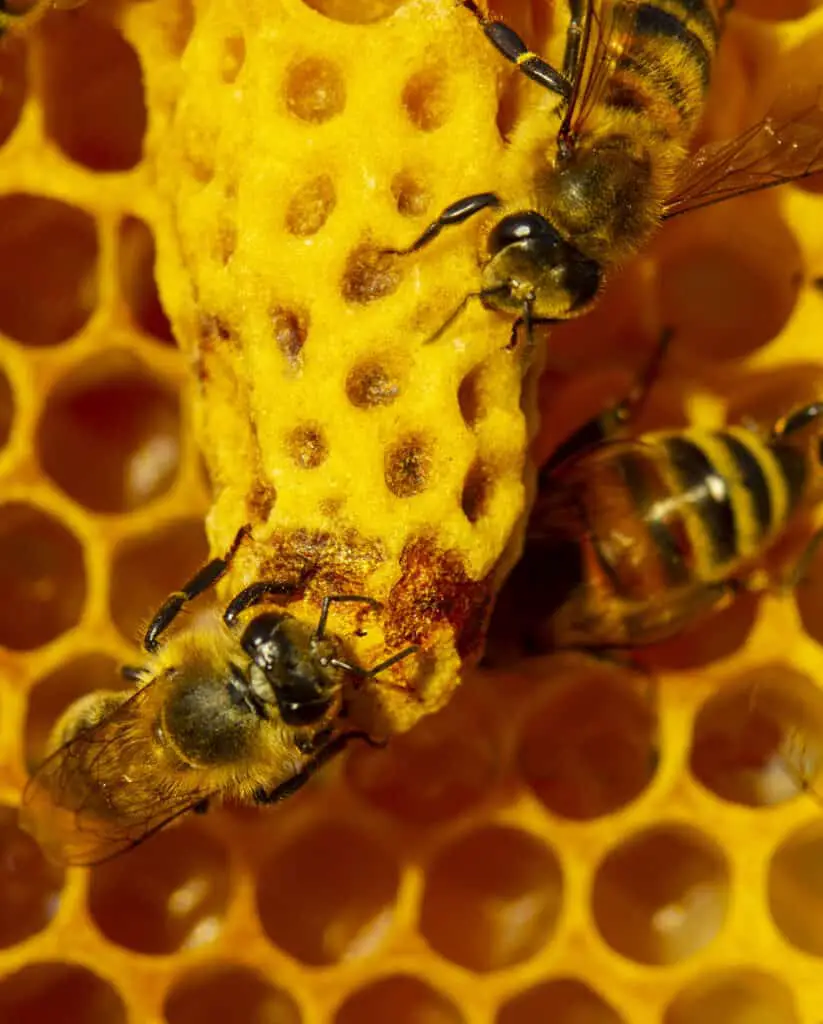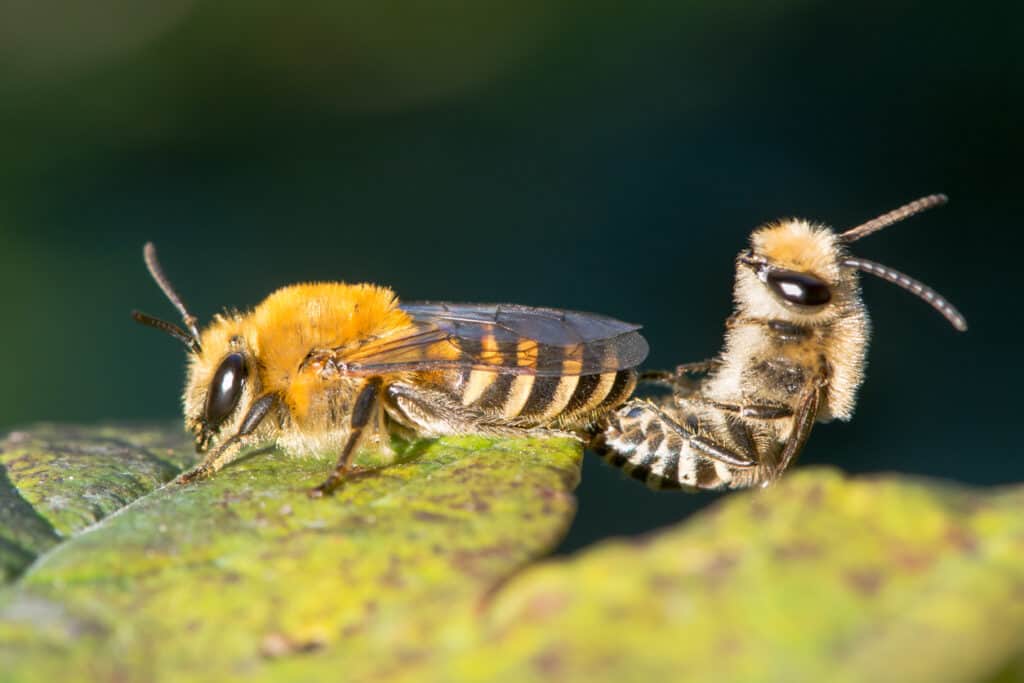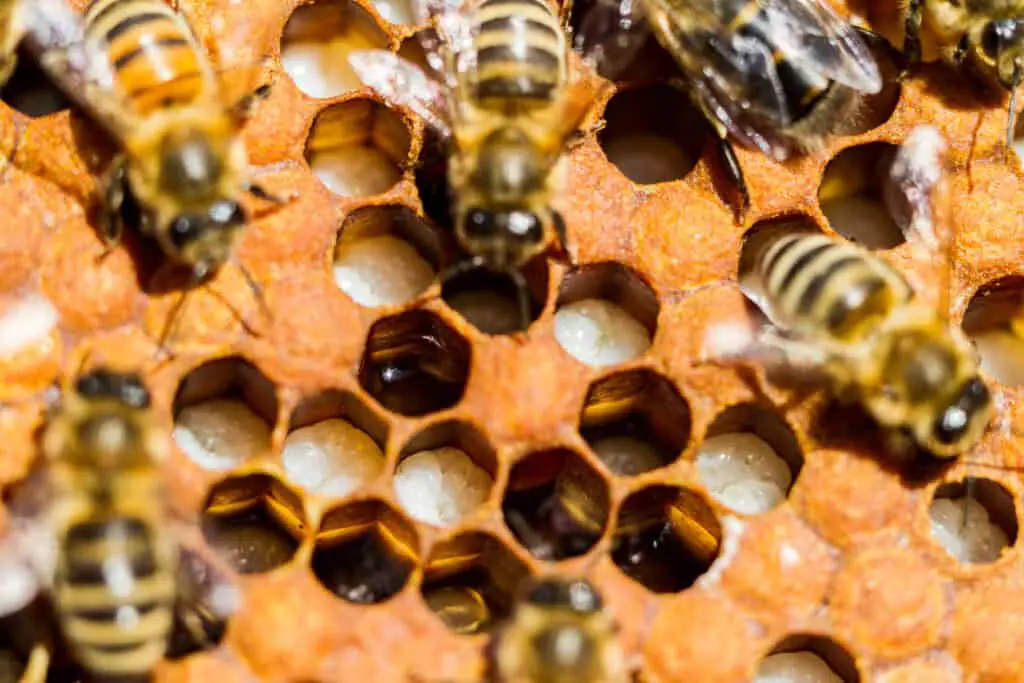Whether you’re looking to become a beekeeper or simply have an ornate fascination with bees, one of the most exciting aspects about these little insects is their reproductive cycles. So, how exactly do bees reproduce?
For honeybees, the queen bee will fly out in search of male drone bees to mate with and gather enough sperm to help her fertilize eggs for the rest of her life span. A queen bee can lay between 1500 and 2000 eggs a day, which becomes the nursing female worker bee’s responsibility.

There is so much to cover regarding bees’ life cycles and reproductive processes. This fascinating topic will have you researching the intricate systems and designs that keep our much-needed bee population alive for hours. Below is a comprehensive guide covering exactly how bees reproduce.
How Do Honeybees Reproduce?

Honeybees are essential for producing not only honey but the fertilization of plants via the pollen they carry on their bodies while foraging. Environmentalists commonly worry that without bees, the world would plunge into crisis in a mere four years. The reproduction and life cycle of honeybees are crucial to ensuring their survival and ours.
For honeybees to reproduce, their queen bee will need to leave the colony. A colony can only have one queen bee, so all the reproductive work generally falls on a single queen. After her incubation period of around seven days, the queen bee will take a few practice flights outside the colony to build up her strength and train her wings.
Once she is confident that she can withstand the long flight in search of a drone congregation area and is strong enough to fly with a male bee on top of her during the mating period, she leaves the colony with a few drone bees to accompany her.
The queen bee needs to fly quite far in search of other drone bees to mate with, as this ensures the protection of the genes that will form the new generation of honeybees. Like how humans cannot reproduce too close within their gene pool, which increases the risk of birth deficits and abnormalities, honeybees will also need to seek males outside their colonies to ensure adequate gene-mixing.
The Mating Process Of Honeybees

The mating conditions must be perfect for the queen bee to venture out in search of drone bees to mate with. As honeybees do not handle the cold very well, the temperature must be pretty warm for the queen bee to leave the colony.
The temperature must be at least 69 degrees Fahrenheit and the wind speed below 17 mph. It needs to be a relatively perfect day, with no rain and little wind, as honeybees mate 20 – 70 feet above the ground while in flight. A queen bee will typically mate with 15 – 20 drone bees, although in warmer conditions, she may mate with 40 to 50 drone bees and will never mate with the same drone bee twice.
Unfortunately for the drone bees, mating usually means a horrible death. The male drone bee will ejaculate with such force that his endophallus is severed from his body, ripping his abdomen open. He will then fall to the earth and die while his mating sign is still inside the queen bee. This forceful ejaculation is so loud humans can hear it as a popping sound.
Queen Bees Reproductive System
The reproductive system of a queen bee is awe-inspiring as her oviduct can hold up to 100 million sperm.
The queen bee has a spermatheca, a storage sac inside of her body that allows her to store enough spermatozoa (up to 7 million) so that she can fertilize eggs for the remainder of her life, which could be up to four years!
To keep the sperm inside her spermatheca healthy, the female worker bees work tirelessly and around the clock to ensure that the hive is well-ventilated and that there is enough honey for food and, with the help of the male drone bees, they regulate the temperature within the hive.
How Do Bumblebees Reproduce?
Unlike honeybees, bumblebee colonies typically only survive for a single season. During spring, once the weather starts warming, a queen bumblebee will emerge from wherever she has been hibernating for the last few colder months, usually from under a pile of leaves, a bunch of bark, or some forest debris.
Once she has exited hibernation, she can begin the construction of a new nest. The nest is not very large, as she must start laying eggs as soon as possible. These eggs will mature into the worker bumblebees.
It is the female worker bumblebees’ job to continue foraging for the colony, leaving the queen bee in the nest to lay more eggs. The male bumblebees leave the nest to go and forage, and many will never return.
Any new virgin queens will also exit the nest to forage, but mainly they leave to search for males to mate with – bumblebees mate on the ground instead of in the air as honeybees do. Male bumblebees can be pretty aggressive in the mating season and will knock a virgin queen to the ground to start the mating process.
Bumblebees mate during late summer when the weather is still warm, but winter is quickly approaching. A queen bee that has mated will leave in search of a good place where she can hibernate throughout the winter to stay safe until the warmer months when she will emerge and restart a new colony. The rest of the bumblebee colony dies from the cold weather.
How Do Carpenter Bees Reproduce?
Unlike honeybees and bumblebees, carpenter bees do not live in colonies. Instead, carpenter bees live in carefully constructed brood tunnels during the colder months. The carpenter bees that survive the entire winter emerge once the weather warms and start their mating process in the spring.
Once a female carpenter bee has mated with a male bee, she will burrow into wood and excavate a tunnel where she can lay her eggs. Inside this wood tunnel are 5-6 cells to house the carpenter eggs. Each cell is coated with pollen and has a single egg inside. Each cell chamber has a seal to keep it shut, which the female bee forms by regurgitating wood pulp.
In a carpenter bee’s life cycle, each egg lasts only two days before turning into its larvae form, which lasts around 15 days. They will then spend approximately four days in the prepupal stage and about 15 days as a pupa.
Life Cycle Of Honeybees
Honeybees go through four stages during their life cycle: eggs, larva, pupa, and adult. Before the bees are even born, the queen will decide their sex. She can do this by choosing to lay either a fertilized egg, which can either be reared as a new queen – or, more commonly, become a female working bee – or she can lay an unfertilized male egg, which will become a male drone bee.
The queen bee can lay 1500 – 2000 eggs per day, almost double her body weight in eggs. The eggs are laid into cells constructed by the worker bees, and the cell’s width determines whether the queen will lay a fertilized or unfertilized egg. Unfertilized male eggs, which turn into drone bees, have larger cells.
It takes roughly 21 days for worker bees to reach maturity, 16 days for a queen bee, and 24 days for male drone bees to fully mature.
Types Of Honeybees And Their Life Cycles
There are three kinds of honeybees, the female worker bee, the male drone bee, and the female queen bee. Every type of bee has a specific function that keeps the colony thriving. Most notably is the queen bee, as, without the queen bee, there will not be any new eggs to keep the hive functioning.
Queen Bees Life Cycle
The worker nursing bees will give potential future queen bees extra special care. Scientists are still striving to figure out what exactly makes a regular fertilized female egg turn into a queen bee, but we know it lies directly in their diet.
Potential future queen bees are fed a rich diet consisting of royal jelly, which we know is a protein-rich secretion that comes directly from the glands of young worker bees. For the first 2-3 days after hatching, all the bee larvae are fed this royal jelly. However, only potential queen bee larvae get fed the royal jelly until they mature.
The nutrient-rich jelly creates a difference in diet between the average female worker bees and the potential queen bees, which causes the probable queen bee larvae to develop sexual reproductive organs that allow the queen to fertilize future eggs.
Replacing a queen bee with a new queen is called supersedure. As an older queen bee ages, her egg production may diminish, and the number of pheromones she exhibits will lessen. The worker bees will pick up on this decline and begin the process of rearing a new replacement queen bee.
The original queen might decide to leave the hive as she knows there will soon be a replacement queen bee, or the new virgin queen will use her stinger to attack and kill the old queen. Most commonly, the worker bees will swarm the old queen and ball around her, causing her body temperature to rise and eventually lead to her death via overheating.
If a queen bee suddenly dies, the worker bees quickly attempt to create a replacement emergency queen bee from the existing larvae, who will be given an excess of royal jelly to help stimulate the growth of reproductive organs. The emergency queen bees are generally much smaller and have lessened reproductive outputs than regular queen bees.
Queen bees can live for over four years, but this highly depends on whether their reproductive rate and pheromones stay stable.
Worker Bees Life Cycle
The female worker bees keep the hive running all by themselves. They do all the work when it comes to constructing the cells, rearing and nurturing the eggs and larvae, regulating the hive’s temperature, and ensuring adequate airflow.
The worker bees are also the smallest of the honeybees. They ensure that everything in the colony is running smoothly. Worker bees act as nurses for the larvae, ensuring they have an adequate food supply by checking on them every 15 minutes.
A female worker bee larvae will reach maturity after 19 – 22 days and will only live for around 15 – 38 days during the warmer months and 150 – 200 days during the colder months.
Drone Bees Life Cycle
Male drone bees are formed from unfertilized eggs from the queen. Their entire purpose is to find another queen to mate with – only 1 in 1000 drone bees will get the chance to mate with a queen. Drone larvae require larger cells than worker bee larvae, as they grow significantly bigger once matured. It takes around 24 days for a male drone bee to fully mature.
Drone bees do not necessarily add anything of value to the hive except for helping with regulating temperature. Therefore, the female worker bees often band together and kick them out, leaving them to die during the colder months, as they become just another mouth to feed.
On occasion, female worker bees can lay unfertilized male drone eggs. However, this is a bad sign within a hive as it signifies that the queen bee is not carrying out her duties.
Conclusion
A honeybee queen will fly out searching for male drone bee congregation areas, where she will mate with 15 – 20 male drone bees. She then returns to the nest and lays fertilized and unfertilized eggs within 2-3 days. These eggs will form female worker bees, male drone bees, and even potential future queen bees.
Bumblebees have similar reproductive stages, except that they mate on the ground instead of in the air, and the queen bee will usually only mate with one other male bee. Carpenter bees lay 5-6 eggs in cells burrowed into the wood.
References
https://reviveabee.com/how-do-bees-reproduce/#the_anatomy_of_a_queen_bee
https://www.perfectbee.com/learn-about-bees/the-science-of-bees/how-honeybees-reproduce

